The global handheld police radar guns market is projected to grow from USD 71.1 million in 2025 to approximately USD 120.2 million by 2035, recording an absolute increase of USD 49.1 million over the forecast period. This translates into a total growth of 69.1%, with the market forecast to expand at a compound annual growth rate (CAGR) of 5.4% between 2025 and 2035. The overall market size is expected to grow by nearly 1.69X during the same period, supported by the rising adoption of advanced traffic enforcement technologies and increasing demand for portable speed detection solutions.
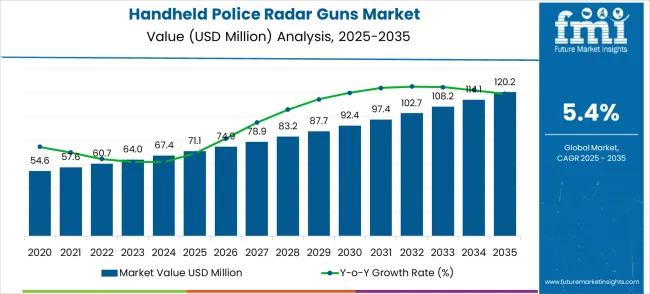
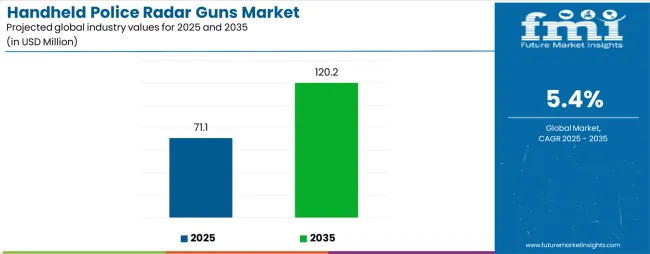
| Handheld Police Radar Guns Market | Value |
|---|---|
| Market Value (2025) | USD 71.1 million |
| Market Forecast Value (2035) | USD 120.2 million |
| Market Forecast CAGR | 5.4% |
The handheld police radar guns market is closely influenced by five interconnected parent markets that collectively drive its adoption and long-term growth. The largest contributor is the law enforcement and traffic enforcement sector, which accounts for about 42% share, as handheld radar guns are essential for detecting speeding vehicles, enforcing traffic laws, and supporting accident reduction initiatives. The road safety and regulatory compliance sector contributes around 23%, driven by government programs, stricter speed monitoring mandates, and smart city initiatives that emphasize portable and accurate speed detection tools.
The technology and equipment innovation segment holds close to 14% influence, supported by ongoing advancements in Doppler and LIDAR technologies, digital integration, and lightweight designs that improve usability, reliability, and evidentiary accuracy in courts. The sports, automotive testing, and industrial applications market adds nearly 12%, as radar guns are increasingly used to measure speed in athletics, vehicle performance testing, and safety assessments across industries. Finally, the emerging markets and developing regions contribute close to 9%, as rising urbanization, growing vehicle populations, and government investment in road safety accelerate the adoption of cost-effective handheld radar devices. Law enforcement and regulatory applications form the backbone of the handheld police radar guns market, while technological innovation, sports and industrial use, and growth in developing economies continue to expand its commercial footprint.
Market expansion is being supported by the rapid increase in traffic enforcement initiatives worldwide and the corresponding need for accurate speed detection equipment that provides superior performance and operational reliability. Modern law enforcement agencies rely on consistent traffic monitoring and enforcement quality to ensure optimal road safety including highway patrol, urban traffic control, and specialized enforcement operations. Even minor detection inaccuracies can require comprehensive enforcement protocol adjustments to maintain optimal safety standards and operational performance.
The growing complexity of traffic enforcement requirements and increasing demand for high-accuracy detection solutions are driving demand for handheld radar gun equipment from certified manufacturers with appropriate performance capabilities and technical expertise. Law enforcement agencies are increasingly requiring documented detection accuracy and equipment reliability to maintain enforcement quality and operational effectiveness. Industry specifications and performance standards are establishing standardized traffic monitoring procedures that require specialized radar technologies and trained operators.
The handheld police radar guns market is entering a transformative growth phase driven by increasing traffic enforcement initiatives, rising road safety awareness, and technological advancement. As law enforcement agencies across both developed and emerging markets seek equipment that delivers superior accuracy, operational reliability, and comprehensive detection capabilities, handheld radar guns are evolving from basic speed detection tools to sophisticated enforcement solutions integrated with digital systems, multi-lane tracking, and advanced signal processing technologies.
Rising urbanization and vehicle density in Asia-Pacific, Latin America, and Middle East & Africa amplify demand, while manufacturers are advancing innovations in digital signal processing, target discrimination, and ergonomic design improvements. Pathways like AI integration, multi-function capabilities, and connectivity-enabled systems promise strong margin uplift, especially in mature markets. Geographic expansion and localization will capture volume growth, particularly where traffic enforcement infrastructure is developing or modernization programs are underway. Regulatory pressures around road safety standards, enforcement accuracy requirements, and traffic management integration provide structural market support.
The market is segmented by technology type, application, and region. By technology type, the market is divided into Doppler radar type, Lidar type, and others. Based on application, the market is categorized into stationary traffic law enforcement, moving traffic law enforcement, and others. Regionally, the market is divided into North America, Europe, East Asia, South Asia & Pacific, Latin America, and Middle East & Africa.
In 2025, the Doppler radar type handheld police radar gun segment is projected to capture around 58% of the total market share, making it the leading technology category. This dominance is largely driven by the widespread adoption of proven Doppler technology that delivers reliable speed detection with excellent accuracy across various traffic conditions. The Doppler radar type is particularly favored for its ability to provide consistent performance in both stationary and mobile enforcement scenarios, ensuring operational flexibility for law enforcement agencies. Highway patrol units, municipal police departments, traffic enforcement divisions, and specialized speed enforcement teams increasingly prefer this technology, as it meets daily traffic monitoring needs without imposing excessive operational costs or complex training requirements. The availability of well-established product lines, along with comprehensive accessory options and technical support from leading manufacturers, further reinforces the segment's market position. This technology category benefits from consistent demand across regions, as it is considered a reliable standard solution for agencies with varying enforcement requirements. The combination of proven accuracy, operational reliability, and cost-effectiveness makes Doppler radar type handheld units a preferred choice, ensuring their continued popularity in the traffic enforcement equipment market. Advanced signal processing capabilities and enhanced target discrimination features continue to drive adoption among professional enforcement agencies seeking superior detection performance.
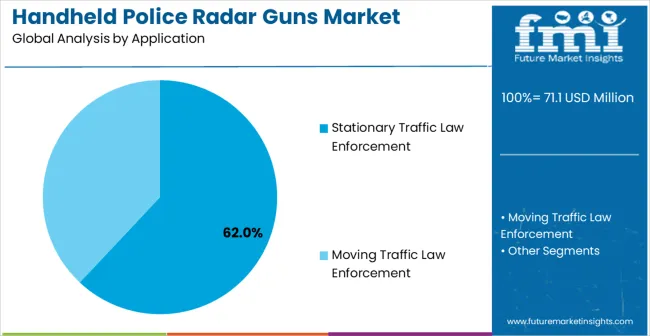
The stationary traffic law enforcement segment is expected to represent 62% of handheld police radar gun demand in 2025, highlighting its position as the most significant application sector. This dominance stems from the unique operational needs of fixed-position speed enforcement, where consistent accuracy and reliable target detection are critical to effective traffic control. Stationary enforcement operations often feature strategic positioning at high-traffic locations that require continuous monitoring throughout extended patrol shifts, demanding dependable and precise speed detection equipment. Handheld radar guns are particularly well-suited to these applications due to their ability to deliver accurate speed readings quickly and effectively, even during periods of heavy traffic flow. As traffic enforcement agencies expand globally and emphasize improved road safety standards, the demand for handheld radar guns continues to rise. The segment also benefits from heightened focus on traffic safety initiatives, where enforcement agencies are increasingly prioritizing accurate speed detection and consistent enforcement as key components of comprehensive traffic management programs. With law enforcement agencies investing in operational effectiveness and public safety enhancement, handheld radar guns provide an essential solution to maintain high-performance speed detection capabilities. The growth of organized traffic enforcement programs, coupled with increased focus on road safety standards, ensures that stationary traffic law enforcement will remain the largest and most stable demand driver for handheld police radar guns in the forecast period. Enhanced targeting capabilities and improved range performance continue to strengthen the segment's market position.
The market is advancing steadily due to increasing traffic enforcement initiatives and growing recognition of the advantages of advanced radar technology over conventional speed detection methods. The market faces challenges, including higher initial equipment costs compared to basic detection devices, a need for specialized training programs for optimal operation, and varying regulatory compliance requirements across different jurisdictions. Technology advancement efforts and performance optimization programs continue to influence equipment development and market adoption patterns.
The growing development of advanced digital signal processing systems is enabling higher detection accuracy with improved target discrimination and reduced false alarm characteristics. Enhanced signal processing technologies and optimized filtering algorithms provide superior speed detection performance while maintaining compliance with law enforcement standards. These technologies are particularly valuable for traffic enforcement agencies that require reliable equipment performance that can support extensive patrol operations with consistent accuracy and operational reliability.
Modern handheld radar gun manufacturers are incorporating advanced multi-lane detection features and ergonomic design improvements that enhance officer efficiency and equipment effectiveness. Integration of advanced target tracking systems and optimized beam patterns enables superior detection results and comprehensive traffic monitoring capabilities. Advanced equipment features support operation in diverse traffic environments while meeting various enforcement requirements and operational specifications, including highway patrol, urban enforcement, and specialized traffic control applications.
The continuous development of enhanced battery technologies and power management systems is extending operational duration while maintaining consistent detection performance throughout extended patrol shifts. Advanced power optimization features and intelligent energy management provide operation capabilities that support comprehensive enforcement activities without performance degradation. These power management innovations are particularly valuable for agencies conducting extended patrol operations where equipment reliability and consistent performance are essential for effective traffic enforcement and officer safety.
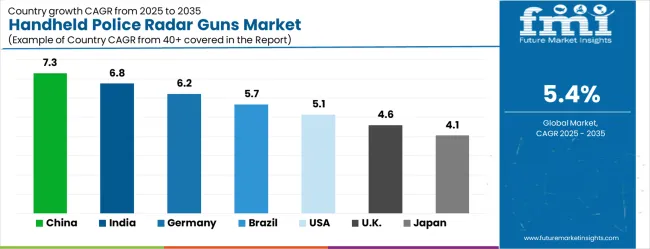
| Country | CAGR (2025-2035) |
|---|---|
| China | 7.3% |
| India | 6.8% |
| Germany | 6.2% |
| Brazil | 5.7% |
| United States | 5.1% |
| United Kingdom | 4.6% |
| Japan | 4.1% |
The handheld police radar guns market is growing rapidly, with China leading at a 7.3% CAGR through 2035, driven by strong traffic enforcement modernization and increasing adoption of advanced speed detection equipment. India follows at 6.8%, supported by rising road safety infrastructure development and growing awareness of traffic enforcement technologies. Germany grows steadily at 6.2%, integrating advanced radar technology into its established traffic enforcement infrastructure. Brazil records 5.7%, emphasizing traffic safety modernization and equipment upgrade initiatives. The United States shows solid growth at 5.1%, focusing on technology enhancement and operational efficiency. The United Kingdom demonstrates steady progress at 4.6%, maintaining established traffic enforcement applications. Japan records 4.1% growth, concentrating on technology advancement and precision optimization.
The report covers an in-depth analysis of 40+ countries, top-performing countries are highlighted below.
Revenue from handheld police radar guns in China is projected to exhibit the highest growth rate with a CAGR of 7.3% through 2035, driven by rapid expansion of traffic enforcement infrastructure and increasing demand for advanced speed detection equipment. The country's growing focus on road safety improvement and expanding traffic patrol operations is creating significant demand for precise speed monitoring solutions. Major equipment manufacturers are establishing comprehensive distribution networks to support the increasing requirements of law enforcement agencies and traffic control authorities across urban and highway patrol applications. Government road safety initiatives are supporting establishment of modern traffic enforcement capabilities and advanced monitoring systems, driving demand for sophisticated radar gun technology throughout major metropolitan areas and highway corridors. Traffic enforcement modernization programs are facilitating adoption of digital radar technology that enhances operational effectiveness and detection accuracy standards across enforcement networks. The Chinese government's commitment to reducing traffic accidents and improving road safety standards is accelerating investments in advanced traffic monitoring equipment. Urban development projects and smart city initiatives are incorporating intelligent traffic management systems that require sophisticated speed detection capabilities.
Revenue from handheld police radar guns in India is expanding at a CAGR of 6.8%, supported by increasing traffic enforcement development and growing awareness of the benefits of advanced speed detection equipment. The country's expanding road infrastructure and rising traffic safety standards are driving demand for professional-grade speed monitoring solutions. Traffic police departments and highway patrol units are gradually implementing advanced radar gun technology to maintain enforcement standards and operational effectiveness. Traffic safety sector growth and enforcement infrastructure development are creating opportunities for equipment suppliers that can support diverse operational requirements and performance specifications. Professional training and certification programs are building technical expertise among enforcement personnel, enabling effective utilization of radar gun technology that meets traffic enforcement standards and detection accuracy requirements across metropolitan regions. India's rapid urbanization and increasing vehicle ownership are intensifying the need for effective traffic management and speed enforcement capabilities. National highway development programs and expressway construction projects are establishing comprehensive traffic monitoring systems that require advanced detection equipment. State government initiatives focusing on road safety improvement and accident reduction are driving procurement of modern radar gun technology for traffic police departments.
Demand for handheld police radar guns in Germany is projected to grow at a CAGR of 6.2%, supported by the country's focus on traffic safety standards and advanced enforcement technology adoption. German law enforcement agencies are implementing sophisticated radar gun systems that meet stringent accuracy requirements and operational specifications. The market is characterized by a focus on equipment precision, operational reliability, and compliance with comprehensive traffic enforcement standards. Traffic safety industry investments are prioritizing advanced radar technology that demonstrates superior detection performance and reliability while meeting German quality and operational standards. Professional certification programs ensure comprehensive technical expertise among enforcement officers, enabling specialized speed detection capabilities that support diverse traffic enforcement applications and operational requirements across regional networks. Germany's commitment to maintaining the highest traffic safety standards in Europe drives continuous investment in cutting-edge enforcement technology. The country's comprehensive traffic monitoring infrastructure requires sophisticated radar equipment that meets strict calibration and accuracy standards. Integration with digital traffic management systems and automated enforcement networks is creating demand for advanced radar gun technology with enhanced connectivity capabilities.
Revenue from handheld police radar guns in Brazil is growing at a CAGR of 5.7%, driven by increasing traffic enforcement development and growing recognition of the advantages of advanced speed detection equipment. The country's expanding highway patrol system is gradually integrating professional-grade radar gun technology to enhance enforcement capabilities and operational effectiveness. Traffic control authorities and police departments are investing in radar gun technology to address evolving road safety requirements and enforcement standards. Enforcement modernization is facilitating adoption of advanced detection technologies that support comprehensive speed monitoring capabilities across highway and urban patrol regions. Professional development programs are enhancing technical capabilities among enforcement personnel, enabling effective radar gun utilization that meets evolving traffic safety standards and operational requirements throughout enforcement networks. Brazil's extensive highway network and growing commercial transportation sector are driving demand for sophisticated traffic enforcement equipment. Federal and state government initiatives focused on reducing traffic accidents and improving road safety standards are supporting procurement of modern radar gun technology. Urban traffic congestion and increasing vehicle density in major metropolitan areas require enhanced speed monitoring capabilities that can support effective enforcement operations.
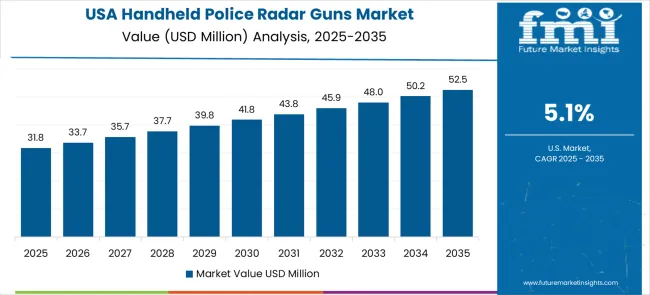
Demand for handheld police radar guns in the U.S. is expanding at a CAGR of 5.1%, driven by established law enforcement agencies and a growing focus on operational efficiency enhancement. Large police departments and highway patrol organizations are implementing comprehensive radar gun capabilities to serve diverse enforcement requirements. The market benefits from established equipment distribution networks and professional training programs that support various traffic enforcement applications. Law enforcement industry leadership is enabling standardized equipment utilization across multiple patrol types, providing consistent detection accuracy and comprehensive operational coverage throughout regional markets. Professional development and certification programs are building specialized technical expertise among enforcement officers, enabling effective radar gun utilization that supports evolving traffic enforcement requirements across metropolitan areas. The U.S. market is characterized by continuous technology advancement and integration with modern law enforcement systems. Federal and state highway safety programs are driving procurement of sophisticated radar gun equipment that meets stringent accuracy and reliability standards. Municipal police departments and county sheriff's offices are modernizing their traffic enforcement capabilities through adoption of advanced speed detection technology.
Demand for handheld police radar guns in the U.K. is projected to grow at a CAGR of 4.6%, supported by established law enforcement sectors and a growing focus on traffic enforcement capabilities. British police departments and highway patrol services are implementing radar gun equipment that meets industry accuracy standards and operational requirements. The market benefits from established traffic enforcement infrastructure and comprehensive training programs for enforcement professionals. Traffic safety investments are prioritizing advanced detection equipment that supports diverse enforcement applications while maintaining established accuracy and operational standards. Professional development programs are building technical expertise among enforcement personnel, enabling specialized radar gun operation capabilities that meet evolving enforcement requirements and accuracy standards throughout regional patrol networks. The United Kingdom's comprehensive road safety strategy and commitment to reducing traffic casualties drive continued investment in advanced enforcement technology. Police constabularies across England, Wales, Scotland, and Northern Ireland are standardizing their speed detection equipment to ensure consistent enforcement capabilities. Integration with national traffic monitoring systems and coordination with local authority enforcement programs requires sophisticated radar gun technology.
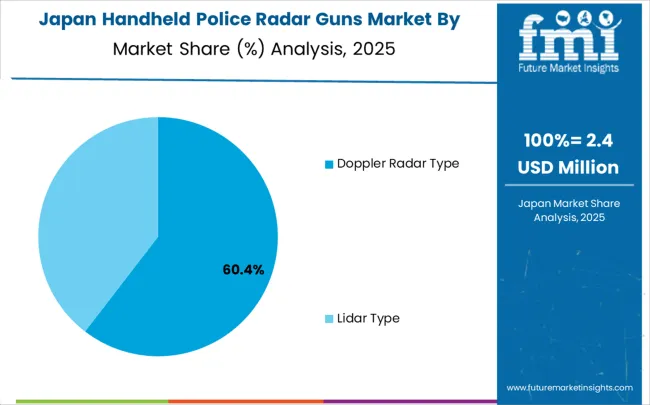
Revenue from handheld police radar guns in Japan is growing at a CAGR of 4.1%, driven by the country's focus on detection technology innovation and precision enhancement applications. Japanese law enforcement agencies are implementing advanced radar gun systems that demonstrate superior accuracy reliability and operational efficiency. The market is characterized by a focus on technological excellence, quality assurance, and integration with established traffic enforcement workflows. Technology industry investments are prioritizing innovative detection solutions that combine advanced radar technology with precision engineering while maintaining Japanese quality and reliability standards. Professional development programs are ensuring comprehensive technical expertise among enforcement officers, enabling specialized speed detection capabilities that support diverse traffic enforcement applications and operational requirements throughout metropolitan enforcement networks. Japan's commitment to maintaining the highest standards of traffic safety and law enforcement drives continuous innovation in speed detection technology. The integration of radar gun systems with intelligent transportation infrastructure and automated monitoring networks requires sophisticated equipment capabilities. Police departments across Japan's prefectures are modernizing their enforcement equipment through procurement of cutting-edge radar gun technology that meets strict performance and reliability standards.
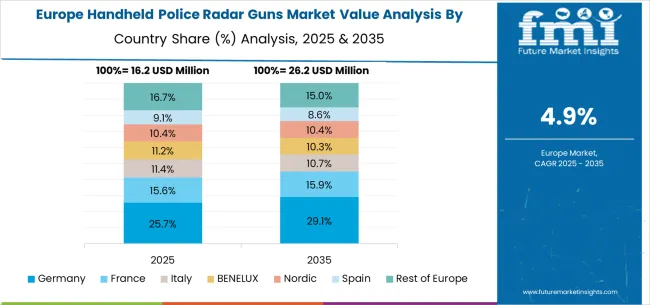
The handheld police radar guns market in Europe is anticipated to expand from USD 20.8 million in 2025 to approximately USD 34.1 million by 2035, reflecting a CAGR of 5.1% during the forecast period. Germany is set to reinforce its leading position, commanding a 28.4% share of the European market in 2025, supported by its established traffic enforcement infrastructure, high standards for operational accuracy, and continuous investment in advanced radar detection technologies. The United Kingdom follows with a market share of 17.6%, benefiting from standardized law enforcement procedures, professional training programs, and a robust focus on road safety modernization. France is projected to capture 15.2% of the regional market, fueled by steady integration of modern speed detection equipment and enhancements in traffic control operations. Italy and Spain together represent 22.6% of total demand, as both countries advance their highway patrol modernization efforts and invest in professional-grade speed detection solutions for traffic authorities. The Rest of Europe, comprising Nordic countries, BENELUX, and Eastern European markets, accounts for 16.2%, driven by regulatory convergence, infrastructure upgrading, and broader adoption of advanced handheld radar gun technology to support evolving road safety requirements and traffic enforcement programs.
The Handheld Police Radar Guns market is defined by competition among specialized equipment manufacturers, law enforcement technology companies, and traffic enforcement solution providers. Companies are investing in advanced radar technology development, detection accuracy optimization, ergonomic design improvements, and comprehensive service capabilities to deliver reliable, accurate, and cost-effective speed detection solutions. Strategic partnerships, technological innovation, and market expansion are central to strengthening product portfolios and market presence.
Stalker Radar (Applied Concepts) offers comprehensive radar gun solutions with established manufacturing expertise and professional-grade detection capabilities. MPD (Kustom Signals, MPH Industries) provides specialized speed detection equipment with a focus on accuracy reliability and operational efficiency. Decatur Electronics delivers advanced radar technology solutions with a focus on precision and user-friendly operation. Laser Technology Inc. specializes in professional detection equipment with advanced radar technology integration.
Pocket Radar offers portable detection equipment with comprehensive performance support capabilities. Bushnell delivers established speed detection solutions with advanced radar technologies. Pacecat-Photoelectric Technology provides specialized detection equipment with a focus on performance optimization. Qingdao Yizhuo Optoelectronic Technology and Xi'an Lei Tong Science & Technology offer specialized manufacturing expertise, equipment reliability, and comprehensive product development across global and regional market segments.
| Item | Value |
|---|---|
| Quantitative Units | USD 71.1 million |
| Technology Type | Doppler Radar Type, Lidar Type |
| Application | Stationary Traffic Law Enforcement, Moving Traffic Law Enforcement |
| Regions Covered | North America, Europe, East Asia, South Asia & Pacific, Latin America, Middle East & Africa |
| Country Covered | China, India, Germany, Brazil, United States, United Kingdom, Japan, and 40+ countries |
| Key Companies Profiled | Stalker Radar (Applied Concepts), MPD (Kustom Signals, MPH Industries), Decatur Electronics, Laser Technology Inc, Pocket Radar, Bushnell, Pacecat-Photoelectric Technology, Qingdao Yizhuo Optoelectronic Technology, Xi'An Lei Tong Science & Technology |
| Additional Attributes | Dollar sales by technology type and application segment, regional demand trends across major markets, competitive landscape with established equipment manufacturers and emerging technology providers, customer preferences for different radar technologies and detection options, integration with traffic enforcement systems and monitoring protocols, innovations in digital signal processing and target discrimination technologies, and adoption of ergonomic design features with enhanced accuracy capabilities for improved operational workflows. |
The global handheld police radar guns market is estimated to be valued at USD 71.1 million in 2025.
The market size for the handheld police radar guns market is projected to reach USD 120.2 million by 2035.
The handheld police radar guns market is expected to grow at a 5.4% CAGR between 2025 and 2035.
The key product types in handheld police radar guns market are doppler radar type and lidar type.
In terms of application, stationary traffic law enforcement segment to command 62.0% share in the handheld police radar guns market in 2025.






Our Research Products

The "Full Research Suite" delivers actionable market intel, deep dives on markets or technologies, so clients act faster, cut risk, and unlock growth.

The Leaderboard benchmarks and ranks top vendors, classifying them as Established Leaders, Leading Challengers, or Disruptors & Challengers.

Locates where complements amplify value and substitutes erode it, forecasting net impact by horizon

We deliver granular, decision-grade intel: market sizing, 5-year forecasts, pricing, adoption, usage, revenue, and operational KPIs—plus competitor tracking, regulation, and value chains—across 60 countries broadly.

Spot the shifts before they hit your P&L. We track inflection points, adoption curves, pricing moves, and ecosystem plays to show where demand is heading, why it is changing, and what to do next across high-growth markets and disruptive tech

Real-time reads of user behavior. We track shifting priorities, perceptions of today’s and next-gen services, and provider experience, then pace how fast tech moves from trial to adoption, blending buyer, consumer, and channel inputs with social signals (#WhySwitch, #UX).

Partner with our analyst team to build a custom report designed around your business priorities. From analysing market trends to assessing competitors or crafting bespoke datasets, we tailor insights to your needs.
Supplier Intelligence
Discovery & Profiling
Capacity & Footprint
Performance & Risk
Compliance & Governance
Commercial Readiness
Who Supplies Whom
Scorecards & Shortlists
Playbooks & Docs
Category Intelligence
Definition & Scope
Demand & Use Cases
Cost Drivers
Market Structure
Supply Chain Map
Trade & Policy
Operating Norms
Deliverables
Buyer Intelligence
Account Basics
Spend & Scope
Procurement Model
Vendor Requirements
Terms & Policies
Entry Strategy
Pain Points & Triggers
Outputs
Pricing Analysis
Benchmarks
Trends
Should-Cost
Indexation
Landed Cost
Commercial Terms
Deliverables
Brand Analysis
Positioning & Value Prop
Share & Presence
Customer Evidence
Go-to-Market
Digital & Reputation
Compliance & Trust
KPIs & Gaps
Outputs
Full Research Suite comprises of:
Market outlook & trends analysis
Interviews & case studies
Strategic recommendations
Vendor profiles & capabilities analysis
5-year forecasts
8 regions and 60+ country-level data splits
Market segment data splits
12 months of continuous data updates
DELIVERED AS:
PDF EXCEL ONLINE
Handheld Electrostatic Meter Market Size and Share Forecast Outlook 2025 to 2035
Handheld Ultrasound Scanner Market Size and Share Forecast Outlook 2025 to 2035
Handheld Tagging Gun Market Forecast and Outlook 2025 to 2035
Handheld Imaging Systems Market Size and Share Forecast Outlook 2025 to 2035
Handheld XRF Analyzers Market Size and Share Forecast Outlook 2025 to 2035
Handheld DNA Reader Market Size and Share Forecast Outlook 2025 to 2035
Handheld Robotic Navigation Market Analysis - Size, Share, and Forecast Outlook 2025 to 2035
Handheld Mesh Nebulizer Market Size and Share Forecast Outlook 2025 to 2035
Handheld Chemical and Metal Detector Market Size and Share Forecast Outlook 2025 to 2035
Handheld Dental X-Ray Systems Market Analysis - Size, Share, and Forecast 2025 to 2035
Handheld Concrete Saws Market Size and Share Forecast Outlook 2025 to 2035
Handheld Point of Sale Market Analysis - Size, Share, and Forecast Outlook 2025 to 2035
Handheld Arthroscopic Instruments Market Growth – Trends & Forecast 2025 to 2035
Handheld Marijuana Vaporizer Market Insights – Demand & Forecast 2025-2035
Handheld Device Accessories Market
Handheld GPS Units Market
Handheld Retinal Scanners Market
Handheld DC Torque Tools Market
Rugged Handheld Electronic Devices Market Analysis – Size, Share & Forecast 2025 to 2035
Cordless Handheld Cultivator Market Size and Share Forecast Outlook 2025 to 2035

Thank you!
You will receive an email from our Business Development Manager. Please be sure to check your SPAM/JUNK folder too.
Chat With
MaRIA